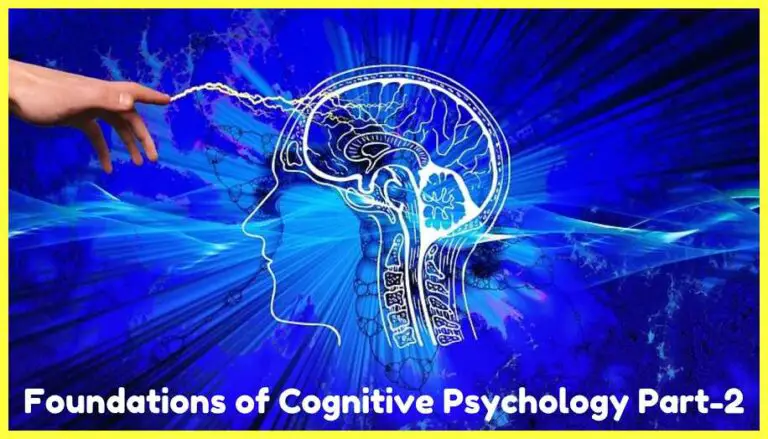Foundations of Cognitive Psychology
This article focuses on the characterization of the brain as an information processing system. Foundations of Cognitive Psychology, In order to uncover the functional architecture of the mind, Marr (1982) proposed three levels of explanations, viz., Computational, Algorithmic, and Implementation levels. In line with this approach, this Article is primarily on the representation of mental functions in hardware/software frameworks.
In today’s Article, we would actually move towards a different kind of a dichotomy, something you might have already heard is this hardware and software distinction that we make between the mind and the brain this is probably one of the most used analogies, borrowed from computer science but something which kind of also has its own assumptions.
so let us examine those assumptions and see how they help us in understanding this relationship between the mind and behavior.
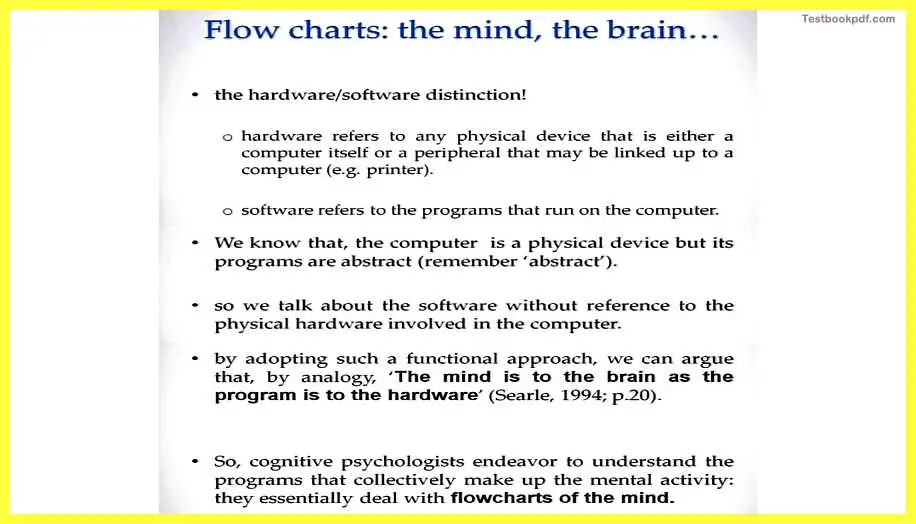
Hardware
If you see it refers to any physical device that is either a computer itself or it is a peripheral, like your mouse your keyboard things like that.
Software
Software refers to the programs that run on the computer, So there is this distinction between what hardware is and what software is?
Now we know that a computer is a physical device but its programs are abstract, so whatever the computer does is actually abstract that is what the software part is, so we talk about the software generally without reference to the physical hardware of the company.
For example – I saw this movie on the computer ok we do not really talk about that there was a disc going round and round in the DVD player of the computer, which led me to watch the movie, we generally just say we saw the movie on the computer, laptop, etc.
We generally talking about just the software part not really referring to the hardware part all the time, this is pretty much what we can actually do about the human behavior or human mind as well we can very well and comfortably talk about the different mental functions without always referring to the what is happening in the hardware or the neural part that is your brain, If you adopt such a function approach for the human mind behavior we can actually say something to the effect like the mind is to the brain as the program is to the hardware, This is something which was given by Searle it was his statement he said that in 1994 ah so cognitive psychologists actually endeavor to understand these programs they want to understand the programs that collectively make up the mental activity, which is what basically then can be described as the flow charts of the mind, So what all things happen what all decision decisions take place in the mental world in the mental states that lead to particular kinds of behavior.
For example – you might be feeling sad that sadness leads you to feel hungry and if you are hungry you overeat, things like that, so we will be talking about, so the idea is that this is the general level of explanation or general currency of conversation that really cognitive psychologists engage in.
Let me take an example here – let us now talk about the brain for a while let us talk about a thermostat a rather simple device.
Here you can see a flow chart of how the thermostat actually functions, at the top, you can see that the thermostat needs to start –
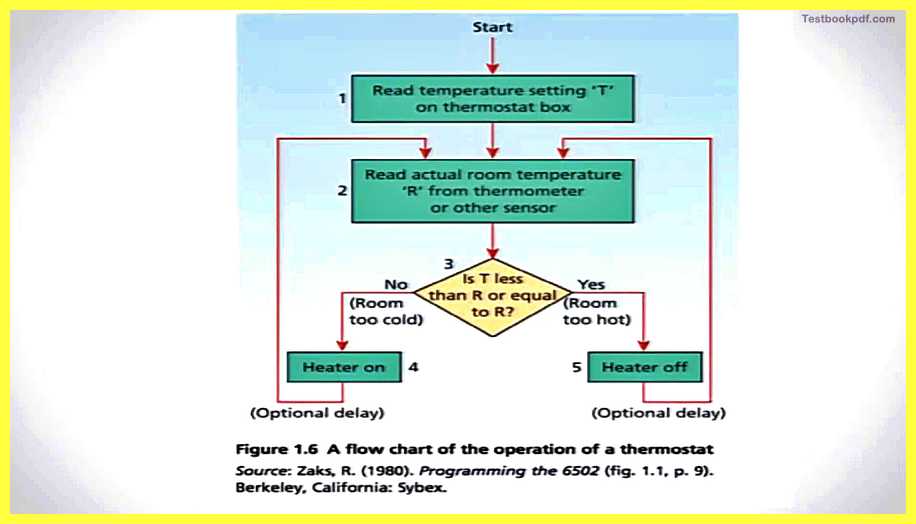
- The first step that it will take is actually it will read the thermostat box, and what the temperature is being registered at the thermostat box.
- The second thing is it then read the actual room temperature wherever the thermostat is actually placed, you can do that with the help of a thermometer or some other kind of sensor.
- The third step that can happen is that it compares the two temperatures so it compares the temperature t of the thermostat box to the temperature r which is the room temperature so the question could be like is t less than or equal to r and there could be two possibilities.
If the temperature t is is not less than or equal to r that is the room is too cold then what you do is then the heater gets on then the thermostat actually takes a decision that the heater needs to go on so that we increase the r to the level of the t which is the thermostat box.
In another scenario what might happen is that the temperature t is less than or equal to r that is room is actually too hot now, so what it might need to do is it will switch off the heater and this is what can keep on happening in a cycle in terms of wherever you place the thermostat.
Now you see here I just talked about the decisions and the calculations and the evaluations that the thermostat box was doing without really referring to what is the details of the sensor that really measures the temperature what is the detail of the machine that really compares these two temperatures, pretty much what we aim to do in cognitive psychology as well, to an extent we don’t really want to talk about the neural structures all the time obviously we do and obviously we need to do that for a full explanation but our discussions of mental states and human behavior are not limited by that.
If you see that diagram, well that diagram gives us an idea of the functional parameters of a thermostat it needs to be supplemented with the knowledge of the actual physical components as well, if you just give the last diagram which is the flowchart to somebody, it might not suffice you know to really give him an actual explanation of what the thermostat is about then he would know that how the thermostat functions but say for example there is somebody whose never seen a thermostat.
So, you would need to supply them additionally with the knowledge of the actual physical components that you know are required to build up a thermostat so that is where the whole experience of the thermostat for some individuals for some person really gets completed.
Now, the problem with the human behavior or human mind and this is slightly more complex, when you consider human con cognition we already have a device ready we already have our brains so we do not really know what are the different components and how they attached and those kind of structural connections, etc are not really known to the best possible level.
Reverse Engineering
What we are trying to figure out as cognitive psychologist is just what is going on what is happening in the different areas of the brain and how these different areas of the brain, how activity in the different various areas of the brain is leading to particular kinds of behavior that is what we are trying to do, so in a sense, you could say that we are actually trying to do a kind of reverse engineering, we are not trying to build up something but we are trying to in some sense deconstruct something.
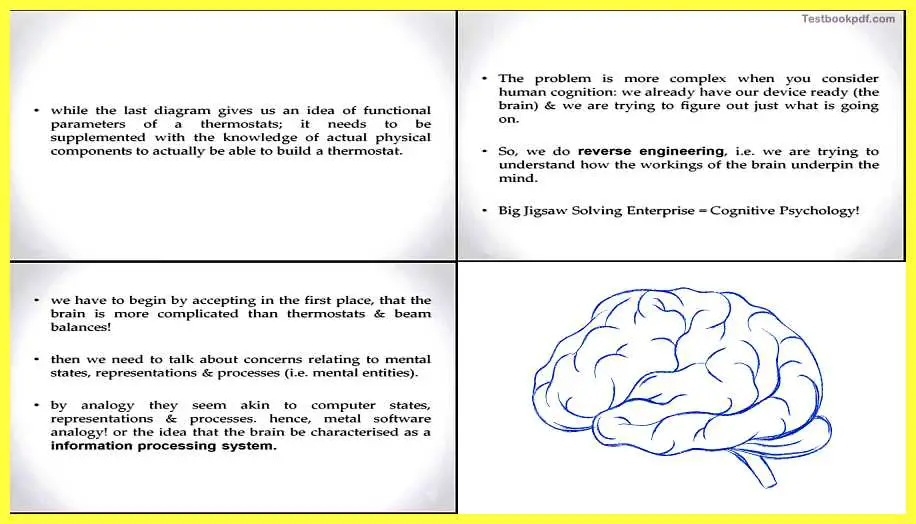
So we are trying to understand how the workings of the brain underpin the human mind.
For example – How can the mind be explained by different neural activities that are going on in the brain that is what we are trying to do, so in some sense, you could also say that you know there is this big jigsaw puzzle kind of a thing that is your human mind and this big jigsaw solving enterprise is what cognitive psychology is actually about so in for some people it can be very interesting for some others it might be a bit dry but the whole idea is that it is rather fascinating to understand how this human mind is made up
On the basis of these different neural activities, we don’t really know what the nature of this human mind is we’re just looking at something which is componential nature which is the human brain, and how that is really leading to the human mind.
There are obviously debates on this issue and that basically goes on in the field of study called philosophy of mind which might also interest some of you.
So we have to begin by accepting in the first place that the brain is slightly more complicated and thermostats and beam balances, so at least that that is the one assumption that you begin with, then what we need to do is to talk about concerns relating to mental states representations and process.
- How is the brain representing the outside world?
- How is the brain leading to these different mental states?
- How is the brain actually leading to the interactions between these mental states?
If you remember an earlier example that I took – William felt hungry and he decided to make a sandwich, how is the brain really supporting this kind of interaction how is the brain, going from feeling hungry to deciding to make a sandwich to actually, doing all that is required to make a sandwich that is what we are actually interested in here, By analogy, these things seem you know very similar to what goes on in a computer, Representations, and process and how is the computer really representing these different numbers how are these calculations really happening, that is why the computer hardware software analogy is actually taken to explain the mind-brain relationship sometimes
Something interesting that one needs to understand is how the brain really works in processing information so how is the brain really regarded as an information processing system we will talk about that as we go ahead in this course.
Then we need to talk about the information from the world how does the information from the world that is your input, the codes that represent this input that is the representation, and how the responses are generated that is the output so I am trying to liken the human brain to what the computer is so there is input which is information from the world there is this representation processes the algorithms and then there is an output that a response is being generated.
David Marr: Three possible levels of explanation
Now somebody who has done an excellent job of actually explaining these interactions and relationships was David Marr, in 1982 David Marr actually came out with these three possible levels of explanation of the kind of interaction we were talking about the mind and the brain interaction, He said that there are three levels at which you can actually explain this interaction.
- The first level which he gave was the level of computational theory.
- The second level that he gave was the level of algorithm.
- The third level that he gave was the level of implementation.
At the level of computational theory, you are basically concerned with what is that the device needs to do and how is in why is it doing it, here is where Marr spells out something which is the logic of strategy.
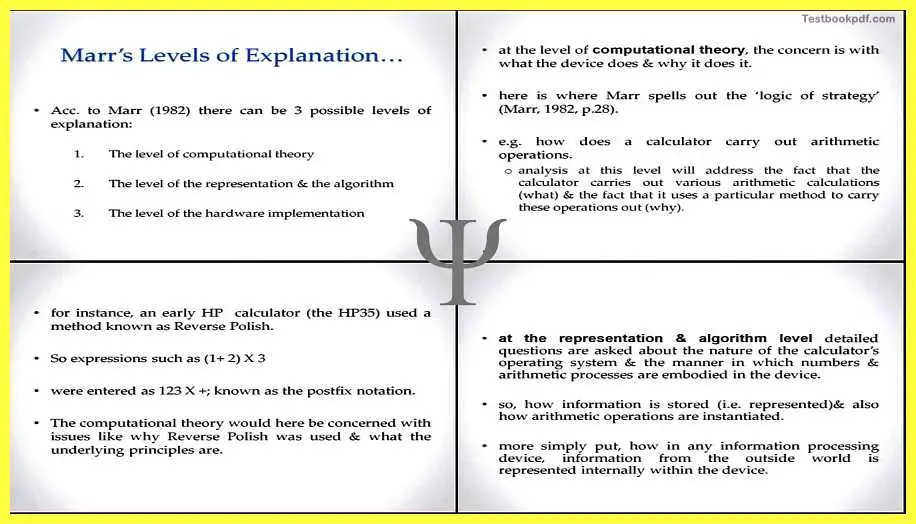
How do you go about doing something, you are not doing it yet you are not really exactly planning all the steps but how do you need to do it how do you need to say for example make tea, you need to have milk water tea and sugar, this is your computational you know that these four things are needed to make Tea.
Another example- how does a calculator carry out arithmetic operations, analysis at this level will actually address the fact that the calculator carries out these various arithmetic calculations and the fact that it needs a particular method to carry out these calculations, the fact that it does and the fact that there has to be a method when we talk about the method we will go to the next level.
Just talking about the computational part a bit more for example – if you have this early hp calculator this basically uses a method called reverse polish so if you give it an expression like 1 plus 2 multiplied by 3 and 1 plus 2 is in parenthesis then you would need to enter these like 1 2 and 3 you enter all the numbers first and then you actually enter the operators, this is basically known as the post-fixed notation, so the computational level explanation or the computational theory basically in this will be concerned with issues like why do you need to use reverse polish here and what are the underlying principles of reverse polish that you actually use here to solve that problem or to explain that problem in some sense, that is your computational level of explanation.
Algorithm level
What do we need ahead – then we need an algorithm how do you really implement these steps, this is the level or the representation the algorithm level is the level where questions are actually asked about the nature of the calculator operating system what kind of an operating system is there, what are the steps that it will take and the manner in which the numbers are represented embodied in the device, so we are talking about a calculator here how information is stored, how arithmetic operations are instantiated.
For example – how does a calculator store numbers 2 3 4 and how does it invoke the addition and those kinds of things, those things you are actually talking about when you are talking about the algorithm and the representation level.
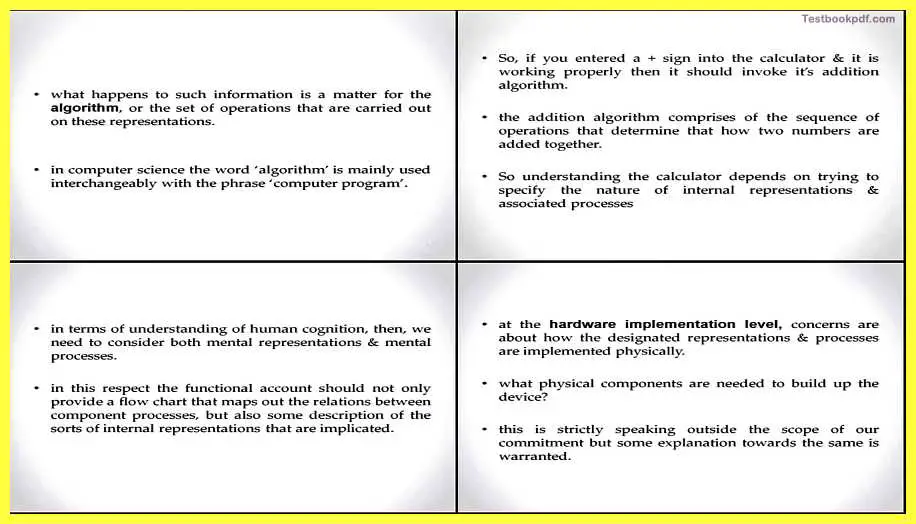
More simply put how in any information so if you just leave the example of the calculator for a while and talk about any information processing system. the question will be, how in any information processing system the information from the outside world is represented.
For example – we see a lot of things how the picture of or how this object right in front of me is represented in my eyes or in my brain, what are those aspects in my eyes and in the brain that are actually helping me code the object outside which I am actually seeing you know that is the level of representation that you need to be talking about.
Calculator Example
For example – when number 2 is entered into the calculator it is represented by some form of this electronic code now this electronic code is what represents number 2 you know that is your internal representation level.
By analogy when we talk about the mind, the mind the mental states basically need to represent the actual states in the world.
If you are walking in the garden and you see a flower if you see a rose for example there will be a representation of the color in the shape of the rose in your head through your eyes which basically you will then, the process and say for example have memories about and stuff but the first step or the most basic step is how is that color red represented ok that is what is the level of representation and that is what basically this level of representation is all about.
Now, what happens when you have represented red – when you have a set of codes or say a set of neurons that fire to code red what do you do after that what ahead.
So what is ahead basically is explained in the level of algorithm, the level of algorithm basically helps you specify the set of operations that are carried out on those representations so you combine the red and you combine the shape and then you then have a complete perception of water roses.
Similarly, say for example you have to make tea you know that tea and sugar and milk and what is needed the next step will be how do you really combine them to come up with Tea, you will need to know the algorithm and the exact sequence of steps that you will need to take in order to be able to make Tea.
So in computer science, this world algorithm is mainly used interchangeably with the word called program, it is pretty much the same thing as how something is really being done, so if you entered a plus sign (+) into the calculator you know and it is working properly then what it should do is it should invoke the addition algorithm, ok so you typed 1 2 3 and then you typed a plus sign the plus sign should invoke the addition algorithm for these numbers that are there, so the plus sign is telling the computer that invoke the addition algorithm for these representations of numbers that I have already had.
What is this addition algorithm comprised of?
This addition algorithm basically comprises the sequence of operations that determine how these two numbers are going to be added, so then is where you are actually talking about how a particular function is taking place, how this addition is really happening, so understanding a calculator then if you really want to understand and get a good picture of what the calculator does really you know depends on trying to specify the nature of the internal representations, how is the calculator representing numbers and the associated process, how is the calculator actually really adding up stuff, this is what you want to talk about when you are talking about the representation and algorithmic level.
Now in terms of if you leave the calculator and the team making example aside and you come back to the cognition example come back to how mind and behavior are to be explained then what we need to do is we really need to consider both mental processes and mental representations and mental processes, how is the mind representing depth, how is the mind representing color, how is the mind representing shapes and then what it does to combine those, color and shape and depth information to really give you a full perception of.
For example – if there is a person, if there is a place how do you navigate through a park, all of those kinds of things basically are coming from this atomic level of representation, that is something which is one of the most important questions that is there in cognitive psychology that cognitive psychology attempts to explain, in this respect by the way the functional account should not only provide the flow chart that maps out the relationship between these different component processes but also it gives you some description of the sorts of internal representations that are implicated.
Flow chart

so when you talk about a flow chart like we talked about in the example of the thermostat the flow chart should also have that this is how a particular shape or a flower or something, the particular color is represented and this is how it will be combined and that is what will lead you to the full perception or experience of the flower.
Third level
the third level is actually when you really get on to doing things you know how something is really implemented.
for example – in the case of the thermostat what is the sensor exactly, what is the sensor that is really you know measuring the temperature of the room something like that, so at the hardware implementation level concerns are about how the designated representations and processes are implemented physically those kinds of explanations all those kinds of issues, so what physical components are needed to build up the thermostat now this is if you talk about the human brain and you talk about mind and stuff this is pretty much you know slightly out of the scope of our discussion probably that is more suited to a class of neuroscience I will not really be talking about a lot in detail about these things but let me go to a slightly related but a different issue we will talk about some explanations still is deserved that is what we will talk about.
now so if we accept some version of the central state identity theory, the fact that mental events and neural elements are related then we are expect accepting that mental states or processes are nothing but these neural processes so a particular neuron fires that leads to a particular kind of a memory or a particular kind of feeling happiness or sadness and that is what we are talking about.
Reductionism
Now, as you may recall, this may be a fairly assertive position to hold, and there are some questions and disagreements around it. This form of theory, or more specifically, this style of explanatory posture, is known as reductionism. so according to reductionists what they say is that understanding the human mind can be reduced to understanding the basic electrochemical states and processes that characterize the behavior of neurons.
for example – if you completely understand how neuron functions and if you completely understand how the functioning of a neuron affects another neuron and how these all neurons are connected together then you do not really need to worry about mental states at all, it is pretty much that neuron x will fire and neuron y will follow a neuron z will also follow and that will lead to the perception of that so then why do you need to have the perception thing there, you can just say that particular neurons firing lead to particular kinds of behavior, that if you really follow rather strongly can kind of creates problems for cognitive psychology and it kind of is takes you to the assumption that if you understand these physical states completely you have understood what the mind is ok that is the position some of the people in the discipline would like to take as well.
Eliminative Materialism
This is one version, another version of reductionism by the way is called eliminative materialism.
Eliminative materialism as Patricia Churchland states is that, once we have a complete understanding of the behavior of neurons in terms of basic electrochemical principles we can then eliminate any mention of the description of any other level of description then you do not really need to talk about any other levels at all, so that is pretty much what you know is rather similar to the earlier explanation of reductionism that I gave.
Now the point is the question that you you would you know you should ask yourselves and the question that you should you know spend some time wondering about is that, maybe then we can get rid of the mind even, what we can just say is that you know these are the in reactions that are going on in the brain and these reactions are directly leading to those kind of behavior so you do not really need to have the mind, last thing you are saying that those could be a help to explain the mind but here i am saying that, why consider mind at all you can just consider that these particular interactions of the neurons and these are happening due to various neurochemicals some hormones are released some neurotransmitters are released, some are physical or chemical explanations there and that is pretty much what is leading to particular kinds of behavior there is no need of having the mind or mental states or all of that, it’s a slightly harder stance, this is called eliminative materialism a more harder stance of what reductionism is about.
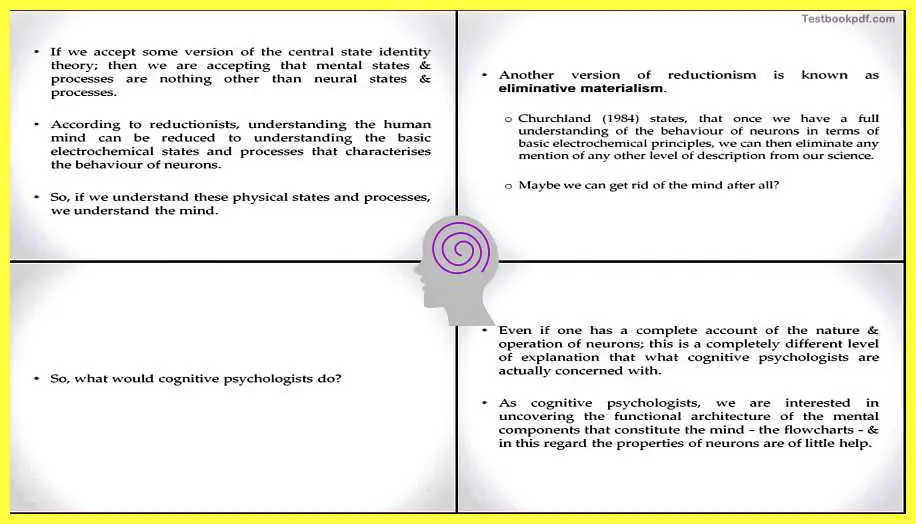
Now, if this happens
For example – at some point of time i do not think that time is anywhere near but at some point in time if the neuro scientist really go to that level and they understand completely what are the functionings of different parts of the brain are, what each of the neuron is doing, how they are connected, how the different neurotransmitters hormones etc are controlling these neurons, if that level of expertise and knowledge is reached then what would cognitive psychologists do i mean, then we are out of job practically we don’t have stuff to talk about but there could be some solace, we are actually not focusing ourself on that anyways, even if one has a complete account of the nature and operation of neurons then also this is a completely different level of explanation than what cognitive psychologists actually engage in, we never said that we want to be concerned about how the neuron functions in the first place, we are just saying that we are actually operating at a slightly different level even if you understand how a particular neuron functions and how different connections lead to particular behaviors we are not really concerned with that we are say that ok this kind of activity in the cells or in neurons or in certain regions of the brain lead to this kind behavior and there will be an intervening level of explanation that we will be talking about that is what cognitive psychology anyways is about.
Ok so as cognitive psychologists and that is something which should be sure to all of us is as cognitive psychologists we are interested in uncovering the functional architecture of the mental components that constitute the minds, we just want to know what leads to what.
For example – How memory can lead to a particular experience those kinds of things.
So the flow charts and how a particular decision is taken, how different mental events have connected those kinds of things we are actually worried about, At some point, you will see how limitations of attention can lead to sometimes faulty perceptions of those kinds of things, the entire explanation is then based on mental states and that is where our model successfully rests, not completely but reasonably sure of or reasonably distant from this dependence on the neural states that pretty much what cognitive psychology is about.
Summary
This basically brings me to the end of the series of the foundational assumptions in cognitive psychology this was the Article in the series and so just to sum up we are talking about how mental functions can be represented in the analogy of the hardware and software we also talked about these different levels of description that exist which mark gave and we talked about how these could lead to a different kind of discourse about mental functions so this is the end of the session on foundational assumptions of cognitive psychology, we will go towards some other kinds of approaches to study cognitive psychology in the next Article thank you.
Read also:
Foundations of Cognitive Psychology Theory
A Brief History of Cognitive Psychology Theory pdf (Part-2)
Click here for Complete Psychology Teaching Study Material in Hindi – Lets Learn Squad
